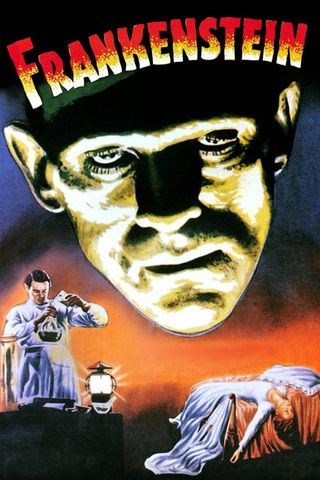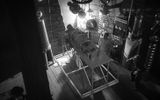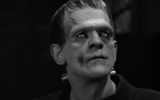SPOILERS

| Added | Sun, 20/09/2020 |
| Release date | 17-03-1932
|
| Original title | Frankenstein
|
| Феномены | |
| References |
Frankenstein is a classic American science fiction horror film based on the play by Peggy Webling, which in turn was based on Mary Shelley's 1818 novel Frankenstein, or the Modern Prometheus. The film adaptation also shows a significant influence of the famous German expressionist film "the Cabinet of Dr. Caligari" (1920).
The flat forehead that is the creature's hallmark may have been inspired by the appearance of the monster played by Charles Ogle in an earlier film adaptation of Frankenstein, directed by James Searle-Dowley in 1910.
The two metal appendages on the sides of the monster's neck, commonly called bolts, are actually electrodes through which electricity passed into its body during the process of being revived.
Mary Shelley's novel does not specify the method by which Frankenstein revives the Monster: the scientist describes the final result of his work, only briefly mentioning the flash of lightning outside the window. In the silent film era, the visual representation of frightening inventions was strongly influenced by Stevenson's Jekyll and Hyde: in the 1910 short film adaptation, the Monster was born in a cauldron of chemicals. According to some surviving descriptions, in the lost 1915 film "Life without a soul", It was revived using a chemical solution injected into the blood (which makes the plot similar to the idea of the film "Reanimator" by Howard Lovecraft). The scene of reviving a monster with electricity, first used in the 1931 film Frankenstein, instantly became a tradition, and all subsequent film adaptations were based on it. Among other scenario finds of this film is the theme of the donor brain, which is also completely absent from the novel, but had a huge impact on the further development of this plot.
The film became one of the most successful films in Universal's so-called classic horror film series and spawned a Grand cinematic tradition that continues to this day with hundreds of feature and television films.
In the film Frankenstein (1931), two metal appendages on the sides of the monster's neck, commonly called bolts, are actually electrodes through which electricity passed into his body during the process of revival. In this film, for the first time, the revival of a monster with the help of electricity was shown, which instantly became a tradition.
In the film "Frankenstein" (Eng. "Frankenstein", 1931), among other scripted finds of this film, there is a theme of a donor brain, which is also completely absent in the novel, but had a huge impact on the further film development of this plot
The film begins with an introduction in which the film's Director, Edward van Sloan, steps out from behind the curtain and addresses the audience with a brief warning:
"Mr. Karl Laemmle thinks it would not be a good idea to start viewing without a friendly warning: we are going to tell the story of Frankenstein, a scientist who sought to create a man in his own image, without thinking about God. This is one of the strangest stories ever told. It deals with the two great mysteries of creation: life and death. I think it will give you a thrill. This may shock you. It may even terrify you. So if any of you feel that you don't want to put your nerves under such strain, you still have a chance to... well, we warned you.»
In his laboratory, equipped in an old mill, the young scientist Henry Frankenstein conducts experiments, the result of which should be the creation of living matter from inanimate. He combines the body parts that he and his hunchbacked assistant Fritz stole from the graves and removed from the gallows, and collects a terrible huge creature from them. It remains to put the brain in the skull, which Fritz must steal from the laboratory of the medical faculty at the University. However, a clueless assistant instead of the brain of an outstanding scientist brings the brain of a criminal. Frankenstein, unaware of this, places the defective brain in the skull of his creation.
Frankenstein's bride Elizabeth, concerned that her fiance is hiding even from her, asks Professor Waldman to influence his former student. They go to the old tower where Frankenstein's laboratory is located, and find themselves there shortly before Frankenstein begins the experiment. During a thunderstorm, a dead body is raised above the roof of a building so that the high-voltage current received from a lightning strike activates a generator of certain "rays of life" that can restore the vital activity of dead tissues. The monster begins to move. "Now I understand what it means to be a God!" exclaims Frankenstein in ecstasy.
The scientist keeps the monster locked in the basement. Sadistic Fritz mocks the creature by teasing it with a burning torch. The monster in despair and rage breaks the shackles and kills Fritz. It is only thanks to a powerful sedative administered by Dr. Waldman that the monster is put to sleep. Frankenstein is depressed. Dr. Waldman convinces him that the monster is extremely dangerous. Frankenstein promises to abandon further experiments. On the day of his wedding, he learns that Dr. Waldman was strangled in the laboratory, and the monster escaped.
On the Bank of the river, a little girl Maria plays with her new friend – a monster. They pick flowers, throw them into the water, and watch them float with the current. When the flowers run out, the monster innocently throws the girl into the water, believing that she will also swim, but the girl drowns. A heartbroken father brings his daughter's body to the village. The wedding turns into a hunt – the villagers, led by Frankenstein, go in search of the monster. Suddenly, Henry comes face to face with his creation. The monster knocks him down and carries his unconscious body to an old windmill. Frankenstein comes to his senses. A fierce struggle ensues. The monster throws its Creator from the top tier, and the locals set fire to the mill, which soon burns down and falls to pieces.
Phenomena in artwork: Zombies
Henry Frankenstein creates a monster by assembling a human body from the corpses of several men that he steals from the cemetery. He puts the killer's alcohol-laced brain, stolen from the medical University, in it. Frankenstein revives the monster with lightning bolts passing through electrodes in its body. According to the scientist, the light of which contains a component of radiation that lies beyond ultraviolet and gives life.
The monster has the rudiments of intelligence. He understands the speech addressed to him, shows emotional reactions (fear, joy), but cannot speak himself. Scientists assumed that the killer's brain would make it attack people, but in fact the monster only kills in defense or out of misunderstanding.
Log in or register to post comments









